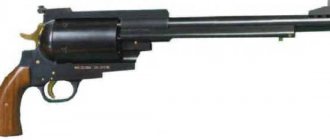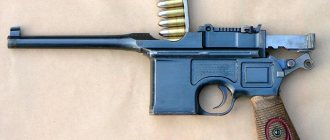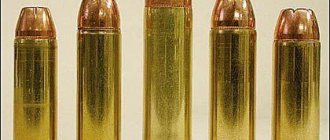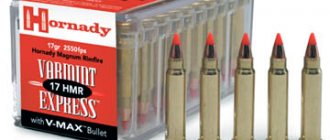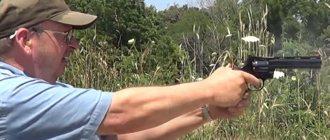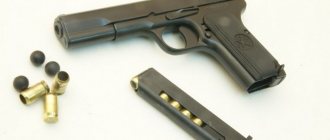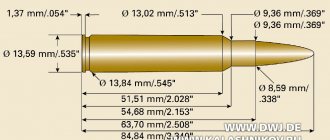Caliber .357 Magnum
In 1955, gun manufacturer Colt released what is probably the finest example of a revolver in .357 Magnum caliber, a model called the Python. The photo shows the perfect embodiment of the Python revolver, the pistol is made of stainless steel, with its most beloved strong features.
Forty years ago, one pistol caliber dominated everywhere and no matter what purpose it was used for; for him it made no difference to serve for government purposes, self-defense, deer hunting or recreational shooting - the most popular pistol was the 357 Magnum caliber revolver.
The US military's adoption of the 9mm Beretta in 1985 dramatically changed the landscape for revolver shooters and devotees of the beloved Colt 1911 in .45 caliber; in both directions of operation: both in law enforcement agencies and the civilian market, the primacy of the new cartridge was won, thanks to the appearance of many self-loading pistols in the 9x19mm caliber. These pistols held more rounds with detachable magazines than the six-shot .357 Magnum or 7+1 in 1911 .45; but for most of the 20th century, 357 Magnum still maintained market dominance. Many experts have expressed the view that if there had not been such a sharp transition in the arms world with the participation of the military towards self-loading in 1980, the .357 Magnum would have remained the most used caliber on the market.
Origins
The cartridge and the .357 Magnum caliber itself were introduced in 1935 by Smith & Wesson, but together with Winchester Ammunition, together they brought it to the market. Majors Douglas B. Wesson and Phil Sharp were responsible for the most recent improvements, although several historical records indicate that both masters consulted Elmer Keith due to his extensive experience in creating heavy bullets, loads that exceed standard power and velocity. 38-44 caliber.
The .38-44 itself was an attempt to develop a more powerful cartridge than the then standard police .38 Special. Smith & Wesson, prior to the introduction of the .357 Magnum, even released a frame-weighted revolver nominally in .38 Special, but classified as .38-44.
At the time of its introduction, the .357 Magnum was in fact the most powerful production pistol cartridge. The standard charge measured by a chronograph had a speed of 460.2 m/s on a 10.23 gram bullet fired from a 22.2 cm barrel. This was not the first attempt to create a powerful pistol cartridge. There were many beginnings before the appearance of the 357, the most notable of which was probably from the Englishman HW Gabbet-Fairfax, developed in 1900, a self-loading pistol for the 9mm Mars caliber. Its stated muzzle velocity was 489.8 m/s with a bullet weight of 10.1 grams. But the British military rejected it at the testing stage; neither the cartridge nor the weapon achieved commercial success.
Smith & Wesson chambered the 357 in the heaviest revolver frame (at the time) known as the "N-frame". The revolver was available on special order, introduced at the height of the Great Depression. Each pistol was registered by production and came with a certificate confirming its registration. The Smith & Wesson "Registered Magnum" revolver and its cartridge soon became shrouded in mystique following famous legendary figures: lawman J. Edgar Hoover (registered #1), military general George S. Patton (registration #506) and Hollywood actor Clark Gable ( was recently sold at auction in 2012 as the closing final lot).
The S&W cartridge was originally intended to be used with 22.2 cm barrels, but since all early "Registered" .357 Magnum revolvers were custom, they had a wide variation in individual characteristics. These revolvers came in at least 23 barrel lengths, specialized sighting mechanisms, and grip combinations.
Advantages of the .357
The name ".357" refers to the barrel diameter, which is also the barrel diameter for the less powerful and older .38 Special cartridge. The .38 Special was introduced in 1902 by Smith & Wesson as the most powerful and efficient cartridge to replace the .38 S&W, .38 Short Colt, and .38 Long Colt. The latter did not last long in military service as a standard pistol cartridge, largely due to performance reproaches and a large number of failures in operations during the Spanish-American War and the Philippine Insurrection.
The .38 Special cartridge was originally loaded with a 10.23 gram lead bullet. with a round nose, its muzzle velocity was 260.6 m/s on a standard revolver and barrel. While the caliber was quite popular among American law enforcement, the .38 Special also faced a lot of criticism for its failures in defending against bad guys, especially during the very violent episodes that took place in the 1930s. This criticism was what drove the idea of creating the .38-44 cartridge (.38 loads for use in a .44 revolver frame) which ultimately led to the .357 Magnum.
Still, in the late 1940s and early 1950s, the 38 Special was the dominant working cartridge in American law enforcement organizations. Its popularity was due to its accuracy and relatively light recoil, and since the case had straight walls, it was easy to reload for recreational shooting.
On the left side is a hand loaded .357 Magnum cartridge with a Keith SWC 10.88 gr bullet. On the right side, according to dry numbers from reference books, its “twin”, a factory-assembled .357 SIG cartridge with an 8.09 gr bullet.
If you look at them in fact, there is no need to explain the potential for a possible increase in power in the 357 M due to the volume of the sleeve, it is apparently larger.
When the developers created the .357 Magnum, they took the existing .38 Special case as a base and simply lengthened it by 2.5 mm. mostly to prevent proper feeding and compromise chamber compatibility on the higher-power cartridge, requiring stronger construction than the .38. The bullet diameter itself is the same as on the .38 Special and .357 Magnum. For training and practical purposes, this meant that the .38 Special cartridge could be safely loaded and fired from any cylinder in the .357 Magnum revolver system; This was probably the strongest aspect for moving from 38 to 357.
History of the revolver
During the Second World War, the entire military industry was aimed at creating relatively cheap mass-produced weapons that could be used in the army. Thanks to this, in the post-war years there was a shortage of individual weapons in the elite segment on the American market.
And in an effort to fill this niche, specialists from Colt's Manufacturing Company began developing a new revolver in the late 40s of the twentieth century.
The fairly popular and powerful .357 Magnum cartridge was chosen as ammunition.
Given their strength, frame type I is taken as the basis. Design, production of prototypes and work on errors took about 6 years.
The official introduction of the new Colt occurred in 1955 along with the .44 Magnum from S&W, which for a long time cemented the peculiar rivalry between these two revolvers. But if the second received the title of the most powerful, then Python is still called one of the most beautiful.
The pistol was produced by Colt's Manufacturing Company until 1999, when it was officially announced that its production would cease. However, until 2005, the Colt Python, also called the Combat Magnum after the cartridge, could be ordered in single units or in small quantities from the Colt Custom Gun Shop.
The revolver was incredibly popular, among its owners were such famous people as Elvis Presley, Spanish and Jordanian monarchs and even Pope Benedict 2. Pistols were made to order for them.
Colt Python became the ancestor of a whole family of Colt revolvers. Its direct descendants are pistols such as Colt Anaconda and Colt Stalker. The 80s and 90s saw the Colt Boa, Grizzly and Kodiak, all of which were heavily influenced by Python.
Performance characteristics of the Colt Python
The performance characteristics of the famous revolver are presented in the following table:
| Ammunition used | .357 Magnum or .38 Special (Python Target model only) |
| Dimensions (height*width) | 150*39mm |
| Barrel length options | 2.5'' (63mm), 3'' (76.5mm), 4'' (102mm), 6'' (153mm), 8'' (204mm) |
| Overall length options | 191mm, 201mm, 236mm, 287mm, 328mm (according to the barrel) |
| Unloaded revolver weight | 1006g, 1034g, 1077g, 1233g, 1386g (according to the barrel) |
| Number of cartridges in the drum | 6 |
Disassembly and care
In order to properly repair and care for air guns, you must be able to disassemble and assemble a revolver. For such activities, you will need simple tools in the form of pliers and a straight-blade screwdriver. The procedure for disassembling a Crosman 357 revolver involves the following steps:
- First you need to unscrew the head located on the left side of the revolver and remove it.
- Next, you need to remove the barrel by applying a little force and picking it up from the back.
- After this, you need to remove the aiming bar and take out the weighting material.
- The pads located on the handle of the weapon are also removable.
- Next, unscrew 2 screws located under the sighting bar and above the removed handle pad. This must be done by first placing the weapon right side down.
ATTENTION. A more detailed analysis of weapons is not recommended for fans of pneumatics.
The revolver is resistant to mechanical damage and is easy to maintain.
Description of the pneumatic revolver Crosman SNR357 (Smith Wesson)
The American manufacturing company Crosman has been manufacturing various air guns for a long period of time.
The modification in question is undoubtedly suitable for conducting recreational fire. The main energy used to fire a shot from a Crosman SNR357 air pistol (Smith Wesson) is carbon dioxide, previously pumped inside the can.
The volume of the cylinder is 12 grams, which is enough to fire about 70 shots. The compartment for installing the cylinder is located inside the pistol grip of the weapon.
The only thing that the shooter should remember is the reduced power of the product when used at sub-zero temperatures. This can also be called the only disadvantage of gas-cylinder pneumatics.
The role of head ammunition is performed by standard steel balls with a diameter of 4.5 millimeters. To load them, the delivery set includes a drum magazine that can hold 6 shells.
The initial speed of the ball at the moment of departure from the smooth barrel is 121 meters per second. This is enough to make several targeted shots at close range.
The muzzle power of the Crosman SNR357 pneumatic revolver (4.5 mm) does not exceed 3 joules, which will allow the buyer to purchase the product without a special license.
Protection against an accidental shot is ensured by the presence of a non-automatic safety lock. With its help, it was possible to completely eliminate serious injury throughout the entire service life.
Firing accuracy is achieved thanks to the integrated front and rear sights. They are located on the upper side of the barrel and make shooting more accurate not only from close but also from medium distances.
The weapon body is manufactured using high-strength and modern materials. These materials include alloy steel and impact-resistant ABS plastic.
The only plastic element is the pistol grip. This was enough to reduce the final weight of the entire structure, and with a body length of 206 millimeters, the weight is 910 grams.
In order to protect the Crosman SNR357 (Smith Wesson) air pistol from corrosion, each steel element is coated with a blued solution, which also gives the steel a dark color.
Model 19 – lightness and comfort
The revolvers that were described earlier were undoubtedly very good. But any good thing can be made even better, which is what the same corporation, Smith & Wesson, did. Experiments with various types of steel and heat treatment processes lasted for a whole year, the purpose of which was to increase the strength of the revolver’s structure without losing its lightness and ease of shooting. As a result, on November 15, 1955, a new brainchild of Smith & Wesson was born - the .357 Combat Magnum, which was later renamed Model 19. This pistol received a lighter and more compact, but at the same time durable frame. Also, for even greater shooting comfort, the cheeks of the revolver handle were enlarged. This model is still produced by some US weapons factories.
Advantages and disadvantages
The Crosman 357 pneumatic revolver has a number of advantages and disadvantages that are fundamental when choosing a weapon.
Advantages:
- The revolver is similar to the legendary Colt Python, which makes it a desirable acquisition for gun connoisseurs.
- The proven operating principle, based on the use of carbon dioxide, makes the revolver reliable and safe.
- High bullet speed, which not every pneumatic can provide.
- High-quality materials used to make weapons ensure a long service life.
- The revolver uses the largest possible airgun cartridge.
- Affordable price.
Flaws:
- The breaking barrel does not accurately fix the charging chamber, so it does not fit tightly to the frame.
- The weapon is equipped with a long trigger, which makes it difficult to fire using self-cocking.
- The rear sight is equipped with a slight play, which is not very convenient when shooting, but does not affect the accuracy of the shot.
IMPORTANT. Many hobbyists believe that the main disadvantage of the revolver is the use of plastic parts. However, the plastic from which the composite weapons are made is of high quality and ensures the durability of the Crosman 357 if used carefully and carefully.
Modern realities
Nowadays, cartridges of this caliber are equipped with bullets weighing from 7.1 to 11.7 g. Light expansive bullets are usually used by civilians for self-defense, while heavier ones are popular among hunting enthusiasts. 357 caliber cartridges are, in principle, very versatile, they are used in almost all areas, be it hunting or sports shooting, both in short-barreled pistols and in light rifles.
Revolvers of this caliber in US police units have been replaced by modern self-loading weapons, but many police officers still prefer to take reliable “old men” with them on duty. In civil society, such weapons are still very popular and, probably, even after dozens of years, interest in them will still not disappear.
